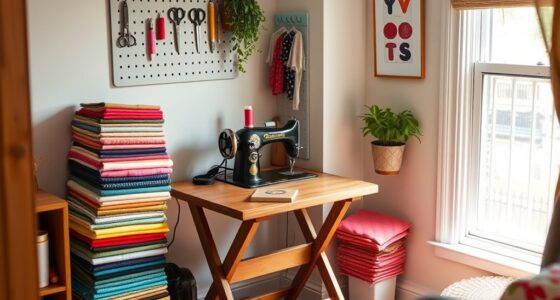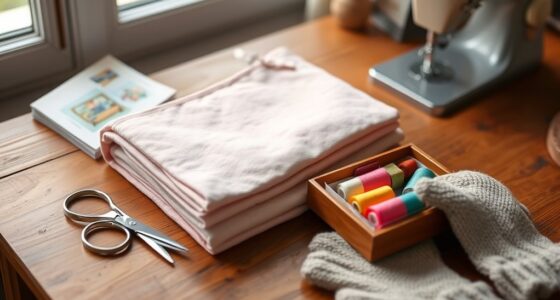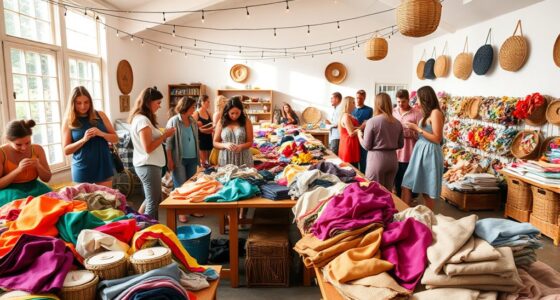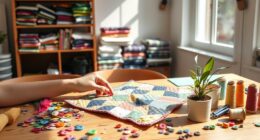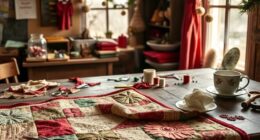To ethically turn your sewing skills into side income, focus on sourcing quality fabrics from trusted suppliers who prioritize ethical practices. Set fair prices that cover your expenses and reflect your craftsmanship, while staying competitive. Building strong relationships with suppliers can give you better deals and early access to new materials. By emphasizing sustainability and quality, you’ll attract loyal customers. Keep exploring proven strategies to grow your sewing side hustle responsibly and successfully.
Key Takeaways
- Source fabrics ethically from vetted suppliers to ensure quality, sustainability, and responsible business practices.
- Price handmade or custom sewing services fairly to reflect skill, effort, and material costs, maintaining profitability.
- Build strong supplier relationships for reliable access to quality fabrics at fair prices, reducing delays and costs.
- Highlight the value of craftsmanship and unique designs to justify pricing, attracting customers seeking ethical, personalized products.
- Offer tiered pricing, discounts, or loyalty incentives to build customer trust and encourage repeat business ethically.
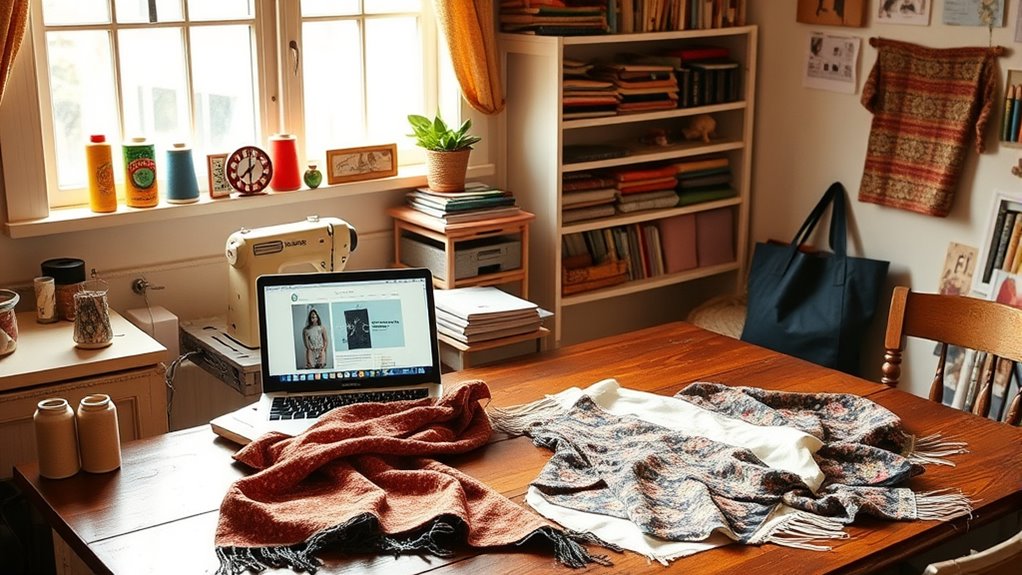
Are you looking for a flexible way to boost your income? Turning sewing into a side hustle can be a rewarding choice, especially if you’re passionate about creating and customizing. One of the first steps is understanding how to manage your fabric sourcing effectively. Finding reliable suppliers for quality fabrics at reasonable prices guarantees your projects remain profitable without sacrificing quality. You might explore local fabric stores, online wholesalers, or even fabric mills that offer discounts for bulk purchases. Building relationships with these suppliers can lead to better deals and priority access to new fabrics, which helps you stay competitive. When sourcing fabric, always consider the type, durability, and ease of care, aligning your choices with your target market’s preferences. Incorporating Vetted fabric sources into your supply chain can ensure consistent quality and ethical standards.
Find reliable fabric suppliers to ensure quality and profitability for your sewing side hustle.
Pricing strategies are equally vital in turning sewing into a sustainable income. You need to set prices that cover your costs and reflect the value of your work, but also remain attractive to buyers. Start by calculating your expenses, including fabric, thread, notions, tools, and time. Then, factor in a reasonable profit margin—don’t undervalue your effort. Research what others in your niche are charging to stay competitive, but avoid simply undercutting prices; instead, emphasize quality and craftsmanship. Offering tiered pricing or discounts for repeat customers can encourage loyalty while maintaining your margins. When determining your prices, consider the market’s perception of your work, your skill level, and the uniqueness of your designs.
Frequently Asked Questions
What Legal Requirements Are Involved in Starting a Sewing Side Business?
When starting your sewing side business, you need to understand the legal requirements involved. You’ll likely need to obtain a business license to operate legally and avoid fines. Additionally, you must meet tax obligations by reporting your income and paying applicable taxes. Keep records of sales and expenses to stay organized. Research local regulations, as rules vary by location, ensuring you stay compliant and avoid future legal issues.
How Do I Price My Sewing Products Competitively?
Think of pricing your sewing products as balancing on a tightrope—you need stability and awareness. To do this, develop a solid pricing strategy by researching your market thoroughly. Look at competitors’ prices and consider your costs and time. This way, you can set competitive prices that attract customers without undervaluing your work. Remember, your goal is to find the sweet spot where quality meets affordability.
What Are the Best Platforms to Sell Sewn Items Ethically?
You should explore platforms like Etsy, which prioritize sustainable sourcing and ethical practices, making them ideal for selling sewn items ethically. Additionally, consider social media channels like Instagram and Facebook for online marketing, allowing you to connect directly with customers who value eco-friendly products. These platforms help you showcase your craftsmanship while emphasizing your commitment to sustainability, ensuring your sewn items reach an audience that appreciates ethical shopping.
How Can I Ensure the Quality of My Sewing Work Consistently?
To guarantee your sewing work stays consistently high-quality, focus on careful material selection and mastering sewing techniques. Choose durable, appropriate fabrics and handle them with precision. Practice stitching, pressing, and finishing methods regularly. Check each piece for consistency, and learn from mistakes to improve. By prioritizing quality materials and refining your skills, you create dependable, professional results that build your reputation and satisfy your customers every time.
What Insurance Options Should I Consider for My Sewing Business?
When considering insurance options for your sewing business, you should focus on liability coverage to protect against accidents or damages. Additionally, look into business policies that cover equipment, inventory, and potential legal issues. These safeguards guarantee you’re financially protected and can handle unforeseen events confidently. By securing the right liability coverage and extensive business policies, you’ll create a solid foundation for your sewing venture’s long-term success.
Conclusion
Turning sewing into a side income allows you to earn ethically, express your creativity, and build a fulfilling hobby. By offering quality, embracing honesty, and maintaining professionalism, you create trust, foster loyalty, and grow your reputation. With dedication, integrity, and passion, you can turn your sewing skills into a sustainable side income. Remember, success comes not just from profits, but from practicing honesty, upholding quality, and valuing your craft every step of the way.



